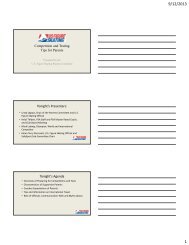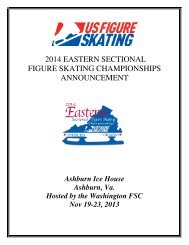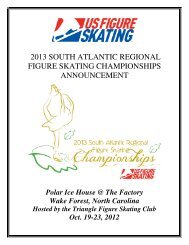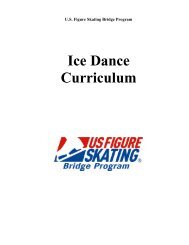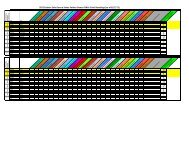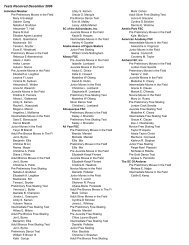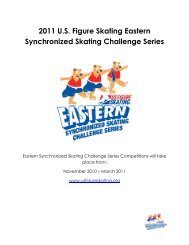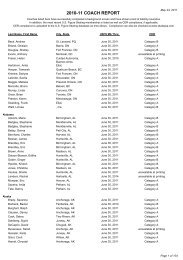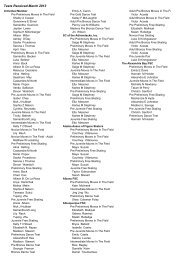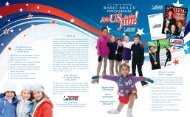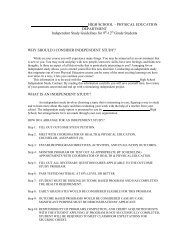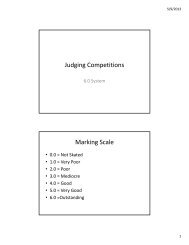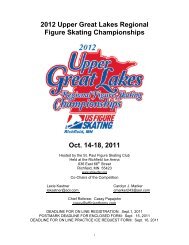Moves in the Field - US Figure Skating
Moves in the Field - US Figure Skating
Moves in the Field - US Figure Skating
- No tags were found...
You also want an ePaper? Increase the reach of your titles
YUMPU automatically turns print PDFs into web optimized ePapers that Google loves.
U.S. <strong>Figure</strong> Skat<strong>in</strong>g Bridge Program<strong>Moves</strong> <strong>in</strong> <strong>the</strong> <strong>Field</strong>Refer to a current U.S. <strong>Figure</strong> Skat<strong>in</strong>g rulebook for patterns
MOVES IN THE FIELDCoach<strong>in</strong>g Po<strong>in</strong>tsPreparationA. Your program should provide several magnum markers if allowed by r<strong>in</strong>k management. Coacheswill use <strong>the</strong>se markers (or <strong>the</strong>ir heel) to draw l<strong>in</strong>es, circles, arcs, cont<strong>in</strong>uous axis, diagonal axis, etc.These on-ice marks will easily be seen dur<strong>in</strong>g <strong>the</strong> session, help organize <strong>the</strong> class and give <strong>the</strong>skaters a visual focus as to <strong>the</strong> MIF pattern and <strong>the</strong> placement of turns steps and patterns.B. The skaters are usually grouped by free skat<strong>in</strong>g level and <strong>the</strong>refore <strong>the</strong> class will have a varietyof MIF test levels. Structure <strong>the</strong> class based on <strong>the</strong> four MIF FOCI; edge, power, extension, andquickness. Present one key element from each of <strong>the</strong> four FOCI dur<strong>in</strong>g <strong>the</strong> class.C. There is an order of skill build<strong>in</strong>g techniques <strong>in</strong> present<strong>in</strong>g a new concept or skill. The follow<strong>in</strong>gis a general format: Teach <strong>the</strong> new skill or concept <strong>in</strong> isolation with m<strong>in</strong>imal speed and <strong>the</strong>n place<strong>the</strong> skill on <strong>the</strong> full ice pattern with <strong>in</strong>creased speed.• If necessary, <strong>the</strong> skill is <strong>in</strong>troduced on two feet and <strong>the</strong>n one foot at <strong>the</strong> barrier.• The skill is <strong>the</strong>n skated away from <strong>the</strong> barrier ei<strong>the</strong>r on an arc, circle, or straight l<strong>in</strong>e us<strong>in</strong>g<strong>the</strong> same system – two feet, <strong>the</strong>n one foot.• Body alignment and free skat<strong>in</strong>g posture are prescribed by you, i.e. head looks <strong>in</strong> <strong>the</strong>direction of travel; arm carriage is level with shoulders relaxed; <strong>the</strong> body weight is over <strong>the</strong>skat<strong>in</strong>g side; <strong>the</strong> free foot is held powerfully over <strong>the</strong> skat<strong>in</strong>g pr<strong>in</strong>t and <strong>the</strong> directions aregiven to <strong>the</strong> exact foot placement as it leaves or takes <strong>the</strong> ice.Key Po<strong>in</strong>ts to Establish with SkatersA. Clearly def<strong>in</strong>e each of four MIF FOCI and give an example of a MIF that has <strong>the</strong>se qualities1. Edge2. Power3. Extension4. QuicknessB. Discuss <strong>the</strong> past history of figures and how MIFs utilize <strong>the</strong> “old” compulsory figure elements.(<strong>Figure</strong> eight, center, push-off, axis, types of turns, etc.)C. Discuss why <strong>the</strong> MIFs improve free skat<strong>in</strong>g or dance discipl<strong>in</strong>es. The MIF test<strong>in</strong>g systemprovides and requires skaters to accomplish:1. Every turn used <strong>in</strong> skat<strong>in</strong>g2. Every edge used <strong>in</strong> skat<strong>in</strong>g3. Every element is done on both sides of <strong>the</strong> body and <strong>in</strong> opposite directions4. MIFs provide <strong>the</strong> build<strong>in</strong>g blocks for: (1) balance, (2) use of <strong>the</strong> blade, (3) control ofbody rotation (“check<strong>in</strong>g ability”), (4) body l<strong>in</strong>e to full extension, (5) <strong>in</strong>creas<strong>in</strong>gspeed and power and (6) accuracy of placement of patternsU.S. <strong>Figure</strong> Skat<strong>in</strong>g Bridge Program
D. The first position a skater establishes is necessary to control:1. Balance2. Rotation of <strong>the</strong> body3. Edge quality of <strong>the</strong> moveE. With additional speed, you will observe and expect <strong>the</strong> skater to demonstrate <strong>in</strong>creased depth ofedges, decreased free leg action, and an <strong>in</strong>crease <strong>in</strong> a “lilt<strong>in</strong>g” knee action. To enhance speed,emphasize stepp<strong>in</strong>g close as <strong>the</strong> feet must take <strong>the</strong> ice under <strong>the</strong> hips.F. To qualify and observe <strong>the</strong> smoothness of <strong>the</strong> skater, observe <strong>the</strong> athlete’s head and arms <strong>in</strong>relationship to <strong>the</strong> horizon. (There should be as little up and down motion as possible). The top of<strong>the</strong> barrier is a recommended horizon for you to observe this quality of efficiency <strong>in</strong> skat<strong>in</strong>g.Lesson Plans –Possible class organization:1. Create a lesson plan to <strong>in</strong>troduce one or more of MIF elements per lesson/session.2. Divide skaters <strong>in</strong>to groups by age/ability. Each coach will teach <strong>the</strong> designatedtechnical skill (5 m<strong>in</strong>utes each).3. The group now jo<strong>in</strong>s as a total unit and will work additional full ice skills andexercises. (5 – 8 m<strong>in</strong>utes)The <strong>Moves</strong> <strong>in</strong> <strong>the</strong> <strong>Field</strong> (MIF) Program is designed to teach <strong>the</strong> skills necessary to attempt <strong>in</strong>creas<strong>in</strong>glymore difficult free skat<strong>in</strong>g, pair or dance elements. Without a mastery of <strong>the</strong> fundamentals at each level,a young person will have little chance of success at a higher level. Remember, each MIF level conta<strong>in</strong>sessential build<strong>in</strong>g blocks of skills that must be mastered before <strong>the</strong> skater is ready to progress to <strong>the</strong> nextlevel.Major Po<strong>in</strong>ts:• The skater should skate <strong>the</strong> correct steps on <strong>the</strong> prescribed edges. For example, when an <strong>in</strong>side edgeis called for, that is what will required to pass.• The skater should skate <strong>the</strong> pattern as closely as possible to <strong>the</strong> diagrams <strong>in</strong> <strong>the</strong> Rulebook. While <strong>the</strong>diagrams are not a set dance pattern, if <strong>the</strong> <strong>Moves</strong> are done on an <strong>in</strong>correct pattern, <strong>the</strong> skaterdevelopment objectives cannot be mastered .• The skater should show a steady and marked progression of skill, mastery and performance at eachlevel as he/she progresses up <strong>the</strong> test structure. It is not merely enough to know <strong>the</strong> steps and getaround <strong>the</strong> r<strong>in</strong>k without fall<strong>in</strong>g!• The skater should demonstrate an <strong>in</strong>creas<strong>in</strong>g ability to execute all prescribed bilateral movementswith equal strength as he or she progresses up <strong>the</strong> test structure. Bilateral movement is <strong>the</strong> ability toexecute movements on both sides of <strong>the</strong> body, clockwise and counterclockwise, forward andbackward.• <strong>Moves</strong> <strong>in</strong> <strong>the</strong> <strong>Field</strong> will cont<strong>in</strong>ue to conta<strong>in</strong> <strong>the</strong> four basic po<strong>in</strong>ts: Edge Quality, Extension,Quickness and Power (refer to <strong>the</strong> follow<strong>in</strong>g page for def<strong>in</strong>itions)U.S. <strong>Figure</strong> Skat<strong>in</strong>g Bridge Program
SKATING STANDARDSFORMOVES IN THE FIELDEdge Quality: Characterized by a stable arc and controlled body rotation; an edge ideally without subcurvesor wobbles, <strong>in</strong>itiated by plac<strong>in</strong>g <strong>the</strong> body and blade on an angle to <strong>the</strong> surface of <strong>the</strong> ice andstepp<strong>in</strong>g on <strong>the</strong> required edge. This edge and arc will ideally commence immediately at <strong>the</strong> po<strong>in</strong>t where<strong>the</strong> skate takes <strong>the</strong> ice or a turn is completed, and travel un<strong>in</strong>terrupted until a required transition takesplace. Depth of edge refers to <strong>the</strong> acuteness of <strong>the</strong> arc and <strong>the</strong> angle of <strong>the</strong> blade.Extension: is controlled stretch<strong>in</strong>g of <strong>the</strong> free leg complimented by an upright body posture. Theextended leg is held <strong>in</strong> an unbroken l<strong>in</strong>e. The height of <strong>the</strong> extension is determ<strong>in</strong>ed by <strong>the</strong> type ofmovement be<strong>in</strong>g executed. However, <strong>the</strong> f<strong>in</strong>al extended position should always be atta<strong>in</strong>ed <strong>in</strong> acontrolled fashion.Quickness: refers to foot-speed. It is <strong>the</strong> precise, rapid and crisp execution of turns, changes of edgeand transitions, usually <strong>in</strong> a brisk and cont<strong>in</strong>uous cadence. Ref<strong>in</strong>ements to acknowledge <strong>in</strong>clude quickmovement that is quiet, fluid and cont<strong>in</strong>uous without disturb<strong>in</strong>g <strong>the</strong> proper and erect carriage of <strong>the</strong>upper body and without <strong>in</strong>terrupt<strong>in</strong>g <strong>the</strong> established rhythm.Power: is <strong>in</strong>tended to mean obvious and rapid acceleration often form a standstill position, achieved bya forceful, gripp<strong>in</strong>g pressure exerted by <strong>the</strong> employed, or skat<strong>in</strong>g leg and skate aga<strong>in</strong>st <strong>the</strong> surface of <strong>the</strong>ice. Power <strong>in</strong>cludes ma<strong>in</strong>ta<strong>in</strong><strong>in</strong>g or <strong>in</strong>creas<strong>in</strong>g speed while execut<strong>in</strong>g various skat<strong>in</strong>g elements. “Power”is relative to <strong>the</strong> size of <strong>the</strong> skater, but can always be atta<strong>in</strong>ed with proper strok<strong>in</strong>g technique.Flow: <strong>the</strong> word “flow” is used to describe <strong>the</strong> ability to ma<strong>in</strong>ta<strong>in</strong> a constant speed across <strong>the</strong> ice whileexecut<strong>in</strong>g various skat<strong>in</strong>g elements and also to refer to <strong>the</strong> length of time it takes for <strong>the</strong> speed generatedfrom a s<strong>in</strong>gle stroke to dim<strong>in</strong>ish.Free Skat<strong>in</strong>g Posture: <strong>the</strong> skaters’ back is straight and <strong>the</strong> head up. The sp<strong>in</strong>e and head areperpendicular to <strong>the</strong> surface of <strong>the</strong> ice. The arms are extended out from <strong>the</strong> shoulders and are level andrelaxed. The free leg is extended <strong>in</strong> a straight l<strong>in</strong>e and lightly turned out from <strong>the</strong> free hip to <strong>the</strong> free toe.Spirals: <strong>in</strong> <strong>the</strong> case of spirals, both <strong>the</strong> free leg and <strong>the</strong> upper body are extended up and away from <strong>the</strong>employed leg and <strong>the</strong> surface of <strong>the</strong> ice. The torso should rema<strong>in</strong> somewhat upright and not collapseddownward, and <strong>the</strong> head should ma<strong>in</strong>ta<strong>in</strong> an upright position follow<strong>in</strong>g <strong>the</strong> natural curve of <strong>the</strong> rest of<strong>the</strong> upper body. The free leg should be straight, turned out and extended at <strong>the</strong> level of <strong>the</strong> hip or higher.Position<strong>in</strong>g of <strong>the</strong> arms is optional.Note: “<strong>Moves</strong> <strong>in</strong> <strong>the</strong> <strong>Field</strong>” have been designed to <strong>in</strong>clude <strong>the</strong> possibility of generat<strong>in</strong>g speed and powerand each transition, when properly executed, conta<strong>in</strong>s a push or pull movement from one of <strong>the</strong> eightedges (forward or backward, <strong>in</strong>side and outside edges, right or left foot).U.S. <strong>Figure</strong> Skat<strong>in</strong>g Bridge Program



